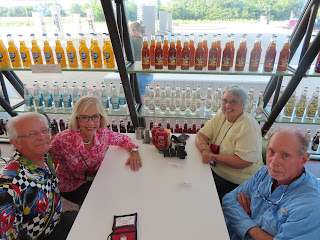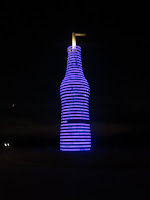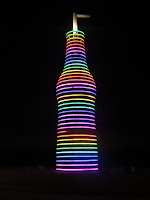We departed Joplin KOA to caravan to Twin Fountains RV Resort in Oklahoma City, OK. We headed south on MO 43, into the little town of Seneca MO. Seneca has a long history starting with the discovery of the beautiful valley which contained two natural water ways, rolling hills, lush foliage and a peaceful atmosphere. The settlers soon realized the natural treasure they had discovered. By the time Missouri became a state in 1821 the valley was already known by the name “Seneca”. This is an Indian name which means “Keeper of the door”. Seneca has always had a rich history.
The Frisco Railroad ran through the Lost Creek Valley, now called Seneca. The railway was the life line to settlers who traveled west-ward. Seneca was the last town before you entered Indian Territory. Because of this it has been nick-named “Little Town on the Border”. The Frisco Railroad ended at Indian Territory, aka the Oklahoma state line. We crossed the Missouri / Oklahoma State line.
I wonder if it is still Indian Territory. Oh no, look at the sign! It’s Eastern Shawnee Nation … I hope they are friendlier than the Indians of gone-by-days!
The Twin Bridges Area at Grand Lake State Park is known for its quiet country atmosphere and excellent fishing for trophy-sized bass, catfish, bluegill and spoonbill. The Grand Lake basin encompasses portions of Arkansas, Kansas, Missouri, and four counties in northeastern Oklahoma, draining a total area of 10,298 square miles. Three major rivers, the Neosho River, the Spring River, and the Elk River drain into the lake.
We turned onto historic Route 66. It is amazing to see the towns that rallied together and thrived and the towns that just withered and died. I will talk about some of these, as we pass through them.
The first town we came to was Afton Oklahoma, sorry to say … I think it withered and died. This town looks like a ghost town, with many, many empty and distressed buildings, along Route 66. Prosperity came to the town when Route 66 barreled through the community in 1926. Soon service stations and motor courts popped up to serve the many travelers along the Mother Road. During these years, Afton provided one of the most popular tourist stops along the Mother Road – that of the Buffalo Ranch, which included not only buffalo but also llamas, yaks, and a petting zoo and barbeque.
Over the next years, businesses that formerly catered to Route 66 travelers, including the Palmer Hotel, Rogers’ Motel, Rest Haven Motel, Green Acres Motel, and more were forced to close. The popular Buffalo Ranch was closed down in 1997. Today it is the home of the Buffalo Ranch Travel Center convenience store. Nothing of the original complex remains, but the new owners occasionally keep a buffalo or two on the premises as an homage to its past. The historic Palmer Hotel built in 1911, suffered a massive fire on July 1, 2020, along with several other historic downtown buildings.
This forlorn sign stands in front of the closed Rest Haven Motel on Route 66 in Afton, OK. Most of the neon tubing is long gone, but it sure would be neat to see the sign restored and lit up again.
The seven unit Avon Motel was built on the west side of Afton in 1936 by John Foley. Carports separated the cabins. Only three of the original seven cabins remain and they are in ruins. You have to look carefully to see the name on the sign.
The next town is Vinita Oklahoma, I think it rallied and thrived! Called “America’s Crossroads,” the term is fitting as Route 66, Interstate 44, U.S. Highways 69 and 60, and State Highway 2 bring travelers and motor freight carriers to the town. In addition, Vinita continues to be an intersection point for the Burlington Northern and Union Pacific Railroads. The second oldest town in Oklahoma. ... The oldest incorporated town on Oklahoma's Route 66.
Will Rogers, who attended Worcester Academy and Willie Halsell College, suggested the idea of a local rodeo, and the Will Rogers Memorial Rodeo began in 1935. Lucien Bell, a lawyer and member of the Sequoyah Constitutional Convention, and Ballerina Yvonne Chouteau were Vinita natives. Others with community ties are Cherokee Chief Thomas M. Buffington, Olympian Jeff Bennett, rodeo cowboy Tee Woolman, television show host Dr. Phil McGraw, former Illinois governor Jim Edgar, and Gene Autry, who lived in Vinita when discovered by Will Rogers. The current Principal Chief of the Cherokee Nation, Church Hoskin, Jr., was born and raised in Vinita.
President Roosevelt’s July 1938 trip across the country began on June 30 at the start of construction of the US Building at the New York World’s Fair in New York City, followed by an address to the National Education Association. His train then stopped in Gettysburg, Pennsylvania; Marietta, Ohio; Covington, Louisville; Bowling Green and Russellville, Kentucky. And finally, a short stop in Booneville, Arkansas before stopping in Vinita Oklahoma just after noon on July 9.
I really love the old architecture you find in these towns. Constructed in 1930, the Hotel Vinita was located on the new federal highway 66 in downtown Vinita. Unlike older hotels, it was not located near the railroad. Instead it catered to the new traveling men of the automobile age. Its architectural design reflects Spanish colonial and baroque motifs.
Catoosa is a fun town … it must be! It has a big Blue Whale as a mascot! The Blue Whale in Catoosa has become a beloved historic landmark along Route 66. The Blue Whale was originally built by Hugh S. Davis, a zoologist and family man who envisioned the whale as a special place where his grandchildren could play and swim in the nearby pond. His sketches of the mammal grew until they reached 20 feet tall and 80 feet long. With the help of a friend, Harold Thomas, the duo spent two years welding the metal framework and applying the hand-mixed cement, one five-gallon bucket at a time. After the whale's completion in July 1972, it attracted visitors from all over and became a place where people swam, fished and picnicked. It is still owned and operated by Davis' daughter, though swimming is no longer available. Over the years, there have been many efforts to refurbish the whale with new paint and facilities.
We merged onto the only section of Interstate-44 with no tolls. It’s the road we are using to get around Tulsa. Route 66, after Tulsa has a mess of turns, so we are heading south on US 75. The bridges on US 75 are very colorful!
The city of Okmulgee takes its name after the Muscogee word meaning “bubbling water.” In 1920, the City of Okmulgee passed a $250,000 bond issue for city projects, including a new hospital. The Okmulgee Colored Hospital would be located in the heart of the African-American residential community, just blocks from their booming business district. Oklahoma’s first “colored hospital” was constructed as a two-story, eighteen-room, and twenty-five bed institution. The building also included living quarters for the hospital staff nurses. However, the newly constructed hospital remained vacant due to inadequate operational funds. In 1924, a group of African-American citizens formed the Colored Hospital Association to fund the operational costs and hospital equipment. Oklahoma’s first African-American hospital officially opened on February 22, 1924.
The Okmulgee Colored Hospital exclusively served African-American patients who were legally and socially separated from mainstream facilities, services and opportunities. The Okmulgee Colored Hospital was designed by African-Americans to serve African-Americans. The hospital boasted an African-American governing Board of Directors, superintendent, physicians and nurses. The Okmulgee Colored Hospital provided those admitted to the facility, the dignity and respect that was not offered by other area hospitals. This hospital was one of a few African-American hospitals in the US and the only dedicated hospital in the state of Oklahoma. The African-American residents of Okmulgee took great pride in their hospital. The hospital remained active until 1957 when Okmulgee opened a ward for African-American patients in the basement of the Okmulgee City Hospital. Thereafter and until 1994, the hospital building served the community in various capacities which included: Grey’s Nursing Home, Smith’s Nursing Home, Deep Fork Community Action Foundation, Inc., American Red Cross, Okmulgee County Youth Services and Shelter, Oklahoma Housing Finance Agency Representatives, and the Veterans of Foreign Wars Representatives. In 1984, the Okmulgee Colored Hospital was listed on the national Register of Historic Places. This facility was described as “the oldest facility of its type in Oklahoma which remains intact.” In the early summer of 2020 a new historical marker which recognizes Oklahoma’s first black hospital was dedicated at the hospital and a 501-3C was born “Landmark of All Generations.”
After we arrived at Twin Fountains RV Resort and got set up. We carpooled to see the Arcadia Round Barn. Naturally, everyone asks … why is it round? Rumor has it, there was a lot of tornadoes in the area. William Harrison figured if they had something round, it would hit and go around it instead of through it. In the early 20th century, round barns were touted to be "cyclone-proof", but there is no scientific evidence to support the belief.
The Arcadia Round Barn is a landmark and tourist attraction on historic U.S. Route 66 in Arcadia, Oklahoma. The Arcadia Round Barn is 60 feet in diameter and 43 feet tall. It was built by local farmer William Harrison Odor in 1898 using native bur oak boards soaked while green and forced into the curves needed for the walls and roof rafters. To construct the curved roof rafters, green 2x4’s were soaked in the river and dried in a curved form. A ladder was built from the loft floor to the point where the apex of the roof would be, 43 feet above the ground. Legend has it that when it came time to fasten the first two rafters at the top, none of Odor’s workers were willing to perform the task. It was up to Odor himself to scale the ladder and tie the rafters together.
Odor’s workers, Rockwood Blevins, and Paul and Fred Fesler, realized that the loft of the barn would be an ideal place for a dance. They offered to pay the difference between the cost of the rough plank floor that had been planned and a smooth hardwood floor if they could hold three dances there. Odor agreed, with the stipulation that “good music” be played. The loft area of the barn is still used today for dances, weddings or any event that someone wants to rent it for!
By 1977, when the Arcadia Round Barn was placed on the National Register of Historic Places, the structure was rapidly decaying, the target of vandals and arsonists. By the late 1980’s, the barn was in severely dilapidated condition. Luke Robison, a retired builder and carpenter, became aware of the barn’s plight and formed The Arcadia Historical and Preservation Society with his wife Anna and Beverly White. On May 27, 1988 Frank Vrana's descendants donated the barn to the Society. Robison had just begun to shore up the structure a few days before when, on June 29, 1988 at 12:09 pm, the decaying roof of the barn “just kind of sighed and fell in, like a soufflé,” according to one witness.
The Society remained undeterred, determined to proceed with the restoration. Restoration work began in 1989. Much of the labor was performed by volunteers, mostly retirees like Robison, who called themselves the Over-the-Hill Gang. When it came time to reconstruct the roof, Robison’s crew replicated the same process believed to have been used by William Odor. Like William Odor before him, the task of attaching the first rafters at the top fell to Luke Robison. The restored Arcadia Round Barn was officially dedicated on April 4, 1992.
Near the Round Barn is a two story sandstone building. This building started life as the First State Bank of Arcadia in 1917. By sometime in 1919 it became a Tuton's Drug Store that operated until 1941. After that it sat empty until 1945 when it became a grocery store which lasted until 1979. This is the only commercial building in this part of Arcadia that survived a huge fire that destroyed all the other buildings in 1924. I wonder if that survival might be in part because of the buildings construction of locally cut sandstone, a type of construction that had been more popular a couple of decades earlier. It looks like someone may be living in it now, or else it’s abandoned.
Helen started talking to John Hargrove, while we were planning the Route 66 caravan. He was so knowledgeable and inviting our large group to come to his home and see his unique place. We met John, such a wonderful man full of knowledge about Route 66 and Oklahoma.
There are so many very cool artifacts, cars, bikes, signs, antiques and much more. I would say that this is one of the many Gems on Route 66. It was built out of a love for all things Route 66, John Hargrove started OK County 66 after he retired.
This piece of land just off the Mother Road in Arcadia lets visitors experience miniaturized versions of major Route 66 attractions across the country, all in one place.
You'll find the Twin Arrows from Arizona, a representation of the logo for the Jackrabbit Trading Post, a Wigwam motel room, a Volkswagen Beetle nose down in the dirt and even a pond with a tiny replica of northeast Oklahoma's famous Blue Whale.
See a small "Route 66 diner" on site that seats a few dozen people and has a movie screen playing iconic Mother Road imagery.
There's something to find on every corner of this property, whether it's a knock-off Captain America motorcycle from the film "Easy Rider," old style gas pumps or vintage signs and for Bob's Big Boy and McDonald's.
The coolest part of the tour of "John's Place" was meeting 3 Route 66 authors! While we were planning the Route 66 caravan, we used the EZ66 Guide by Jerry McClanahan. We also purchased The Route 66 Map Series by Jim Ross, for each caravanner. Today when we visited OK County 66 - John had Jerry and Jim come to talk to us! All three of these guys and Shellee Graham are working hard to keep historic 66 alive and thriving! That is the Yankee RV WOW factor!
We enjoyed dinner at the iconic Pop’s on 66. It’s a modern roadside attraction on Route 66. Using a theme of soda pop, it is marked by a giant neon sign in the shape of a soda pop bottle. The glass walls of the restaurant are decorated with shelves of soda pop bottles, arranged by beverage color.
Whether you need to stop for gas, are looking for a bite to eat or want to try one of their 700 varieties of bottled sodas, POPS is the perfect stop. We enjoyed the restaurant's ultra-modern design as you dine.
Our group sat in the tables under the slanting walls of soda pop while we waited for our meals. Once again, we preselected from 4 entrée choices. I went for the 7 layer salad, while Charlie had the cheeseburger. Cheeseburger was a popular choice, 25 of our 40 caravaneers got the cheeseburger!
The 66 foot tall soda bottle is amazing, at night! It's like its own neon light show!
We also took a late night drive to the spot where Paul McCartney asked for directions is ahead, to your right. See the "Beatles marker". It states "One of the Beatles was here", and tells the story of how Paul with his girlfriend Nancy Shevell, stopped on August 5, 2008 and asked local resident Toby Thompson for directions. It was Paul McCartney's 66th birthday (great occasion to road trip Route 66!). Thompson told his neighbors Jim Ross and his wife Shellee Graham about this brief encounter. In 2020 the District 3 Oklahoma County approved the sign, and Shellee designed it.
It was a great day on Route 66! #twolaneadventures


















































No comments:
Post a Comment